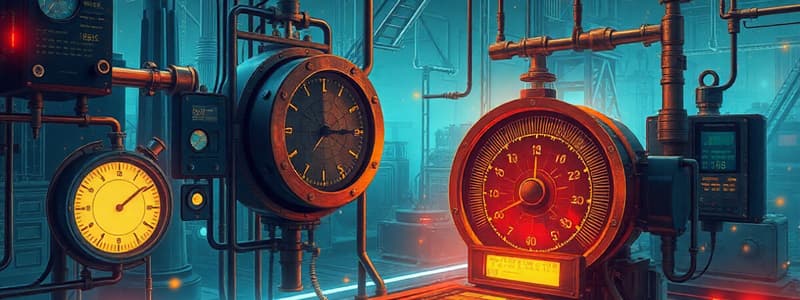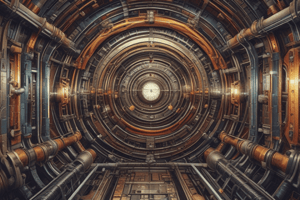Podcast
Questions and Answers
What is the primary function of an instrument?
What is the primary function of an instrument?
- To increase the cost of measurements
- To make measurements of physical quantities (correct)
- To avoid making measurements
- To complicate the measurement process
What does 'instrumentation' refer to?
What does 'instrumentation' refer to?
- The art of avoiding measurements
- The science of designing instruments for measurement (correct)
- The science of avoiding control
- The study of complicated processes
Which of the following units is the SI unit for temperature?
Which of the following units is the SI unit for temperature?
- Watts
- Fahrenheit
- Celsius
- Kelvin (correct)
What is the role of a 'primary sensing element' in a measurement system?
What is the role of a 'primary sensing element' in a measurement system?
What is the function of a 'variable conversion element'?
What is the function of a 'variable conversion element'?
What is the purpose of a 'signal conditioning element'?
What is the purpose of a 'signal conditioning element'?
Which of the following describes a 'data transmission element'?
Which of the following describes a 'data transmission element'?
What is the function of a 'data presentation element'?
What is the function of a 'data presentation element'?
What is 'calibration'?
What is 'calibration'?
Which of the following is the best example of a measurement?
Which of the following is the best example of a measurement?
Flashcards
What is measurement?
What is measurement?
Quantifying or determining the value of a physical quantity.
What is an instrument?
What is an instrument?
A device or tool for making measurements or indicating a physical quantity.
What is instrumentation?
What is instrumentation?
Designing, developing, and utilizing instruments for measurement, control, or analysis.
What is a measurement system?
What is a measurement system?
Signup and view all the flashcards
What is a primary sensing element?
What is a primary sensing element?
Signup and view all the flashcards
What is a Variable conversion element?
What is a Variable conversion element?
Signup and view all the flashcards
What is a variable manipulation element?
What is a variable manipulation element?
Signup and view all the flashcards
What is a signal conditioning element?
What is a signal conditioning element?
Signup and view all the flashcards
What is Data transmission element?
What is Data transmission element?
Signup and view all the flashcards
What is a data presentation element?
What is a data presentation element?
Signup and view all the flashcards
Study Notes
- This chapter introduces functional elements, descriptions, and examples of measurement systems.
Objectives
- Acquire knowledge of functional elements in engineering measurement techniques.
Learning Outcomes
- Identify functional elements of a typical measurement system.
- Evaluate the performance of a typical measurement system.
Measurement
- It quantifies or determines the value of a physical quantity.
- Examples include measuring temperature with a thermometer.
- Determining weight with a weighing scale.
- Gauging pressure with a pressure gauge.
Instrument
- It is a device for making measurements or indicating/recording a physical quantity.
- Examples include thermometers, voltmeters, and pressure transducers which convert pressure to electrical signals.
- Instruments can be analog (e.g., dial gauges) or digital (e.g., digital multimeters).
Instrumentation
- Relates to the science of designing, developing, and using instruments for measurement, control, or analysis.
- Examples are industrial process control and environmental monitoring.
- Involves integrating instruments, sensors, signal processing, and control systems for specific objectives.
SI Units
- Systems International units have been defined to promote a unified measurement system globally.
Common Variables, Input and Output Devices
- Light level sensors include light dependent resistors(LDR), photodiodes, photo-transistors, and solar cells, while output devices include lights & lamps,- LEDs & displays, and fibre optics
- Temperature input devices are thermocouples, thermistors, thermostats, and resistive temperature detectors, and output devices include heaters and fans
- Input devices used for force/pressure are strain gauges, pressure switches and load cells along wih lifts & jacks, electromagnet, and vibration output devices
- Position input devices are potentiometers, encoders, and LVDT, output devices include motors, solenoids and panel meters
- Speed input devices are Tacho-generators, Reflective/Slotted Opto-couplers & doppler effect sensors and output devices AC and DC Motors, Stepper Motors & brakes
- Sound input devices are carbon microphones and Piezo-electric Crystals, and output devices are Bells, Buzzers and Loudspeakers
Sensors
- Sensors include proximity sensors, colour sensors, gas sensors, LDR (light sensor), LM35 (temperature sensor), alcohol sensors, smoke sensor, thermistor (temperature sensor), rain sensor, PIR sensor, water flow sensor, heartbeat sensor, humidity sensor, gyroscope, IR sensor (transmissive/reflective), touch sensor, photo transistor (light sensor), ultrasonic sensor, and soil moisture sensor.
- Cars use sensors for indoor/outdoor temperature, seat belt tension, oil levels, rain, water coolant temperature, wheel speed, anti-theft purposes and fuel level
Measurement Systems
- Comprise instruments, sensors, signal processing, and data acquisition systems for specific measurement tasks.
- Weather monitoring systems collect data, such as temperature, humidity, wind speed, and atmospheric pressure.
- Automotive engine performance testing measures engine speed, fuel consumption, and emissions.
- Measurement systems include hardware (sensors, instruments) and software (data processing algorithms, user interfaces).
Functional Elements of a Measurement System
- Primary sensing element makes first contact with the measured variable which are first detected by a primary sensor or detector and immediately converted into an analogous electrical signal. This is done by a transducer.
- Variable conversion element converts the output signal from the primary sensing element into a suitable form while preserving the information.
- Variable manipulation element manipulates the signal while preserving its original nature. Voltage amplifiers are example
- Signal conditioning element removes noise and interferences from the signal.
- Data transmission element transmits data from one element to another.
- Data presentation element conveys information in a convenient form.
Transducers and Temperature Measurement
- Thermocouples take temperature input and produce a small E.M.F. output.
- Resistance thermometers (RTD) respond to temperature input by changing resistance.
Clinical Thermometer Example
- Mercury in the bulb acts as the primary sensing and variable conversion element.
- Temperature signal converted to volume displacement.
- The capillary tube's cross-section converts volume into a linear distance signal.
- The capillary acts as a signal manipulator and transports data
- The scale on the stem of thermometer consists of the final data presentation stage
- A restriction bend in the clinical thermometers at the junction of the bulb and the capillary, does not allow the back flow of mercury to the bulb once it has expanded to the capillary
- The function of instrument is the restriction in the capillary that acts and serves as the data storage
Loading Effect
- Attempting to make a measurement that modifies the variable being measured is called loading effect.
- Introducing measurement equipment can alter the result from the actual value.
- When an ammeter is inserted in series to measure current, the ammeter's resistance affects the reading.
- Voltmeter readings can change with the insertion of a voltmeter in parallel to voltage
Requirements of Measurement Systems
- They must be fit for purpose by guaranteeing the required accuracy.
- Accuracy requirements vary - some measurements need less (e.g. car speed), some more (e.g. patient temperature).
- Regular calibration is needed to maintain required accuracy.
Calibration
- Involves checking output against a standard of known accuracy.
- Giving the same input for two devices and comparing output
- It should be done across a range of inputs.
- Done at regular intervals because instrument characteristics change over time.
Quality
- The degree to which an object or service satisfies a specified set of attributes or requirements.
- Relates to meeting customer needs and having the necessary features.
- The best available quality device is the one that fits its intended purpose.
Reliability
- The expected level of performance under specified conditions.
- A freshly calibrated reliable measurement system will maintain agreed-upon accuracy levels
- Failure rate reflects how often the system fails to meet required performance, with highly reliable needing low failure rate
- Failure rate calculation: number of failures divided by number of measurements observed multiplied by time observed
Performance Terms and Characteristics
- An instrument is a device used to determine the present value of quantity under measurement.
- Measurement is the process of determining a quantity by comparison to accepted standards.
- Accuracy is how close a measurement is to the expected value.
- Resolution is the smallest change in a variable to which an instrument responds.
- Precision is the consistency or repeatability of measurements where successive readings do not differ.
- Expected value reflects the most probable calculated value one expects to measure
- Error measures the deviation of the true value from the desired value.
- Sensitivity is the ratio of change in output to change in input.
Accuracy Calculations
- Accuracy shows how close the output reading reflects the value in question. The formula is accuracy = [(5/100) x (5)] = ±0.25A.
- True value = lies between (2.0 - 0.25) A and (2.0 +0.25) A = [1.75A, 2.25A].
- Error = true value - measured value.
Precision Characteristics
- Precision shows the degree of agreement within a measurement group and with a few instruments.
- It's based on conformity and the number of significant figures.
Hysteresis and Non-Linearity
- Hysteresis is the difference obtained from increasing or decreasing measurement values
- Hysteresis effect results from bearing friction and slack motion found in some instruments.
- Non-linearity means output is directly proportional to the input in linear relationship for a system
Instrument Range
- Range shows the limits between which readings can be made.
- An ammeter range of 0-4A means values measured between 0A and 4A.
- Thermometer readings of -10°C to 110°C means values measured between -10°C and 110°C will work
Repeatability and Reproducibility
- Repeatability is the ability to give consistent output for repeated input applications, system remaining connected without major changes.
- Reproducibility shows consistent output for constant input but with disconnected system with reinstallation.
Dynamic Characteristics
- Instruments rarely respond immediately to change.
- They exhibit slowness based on mass, thermal capacitance, fluid or electric capacitance.
- Pure delay is encountered often where an instrument waits for reaction.
- Industrial instruments measure quantities that fluctuate with time.
- Speed of response relates to the rate in which an instrument responds to changes.
- Fidelity relates to the degree in which an instrument detects change.
- Lag relates to the delay in response.
- Dynamic error is the difference between values of time, as indicated by instrument.
Studying That Suits You
Use AI to generate personalized quizzes and flashcards to suit your learning preferences.





